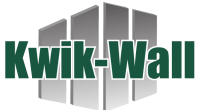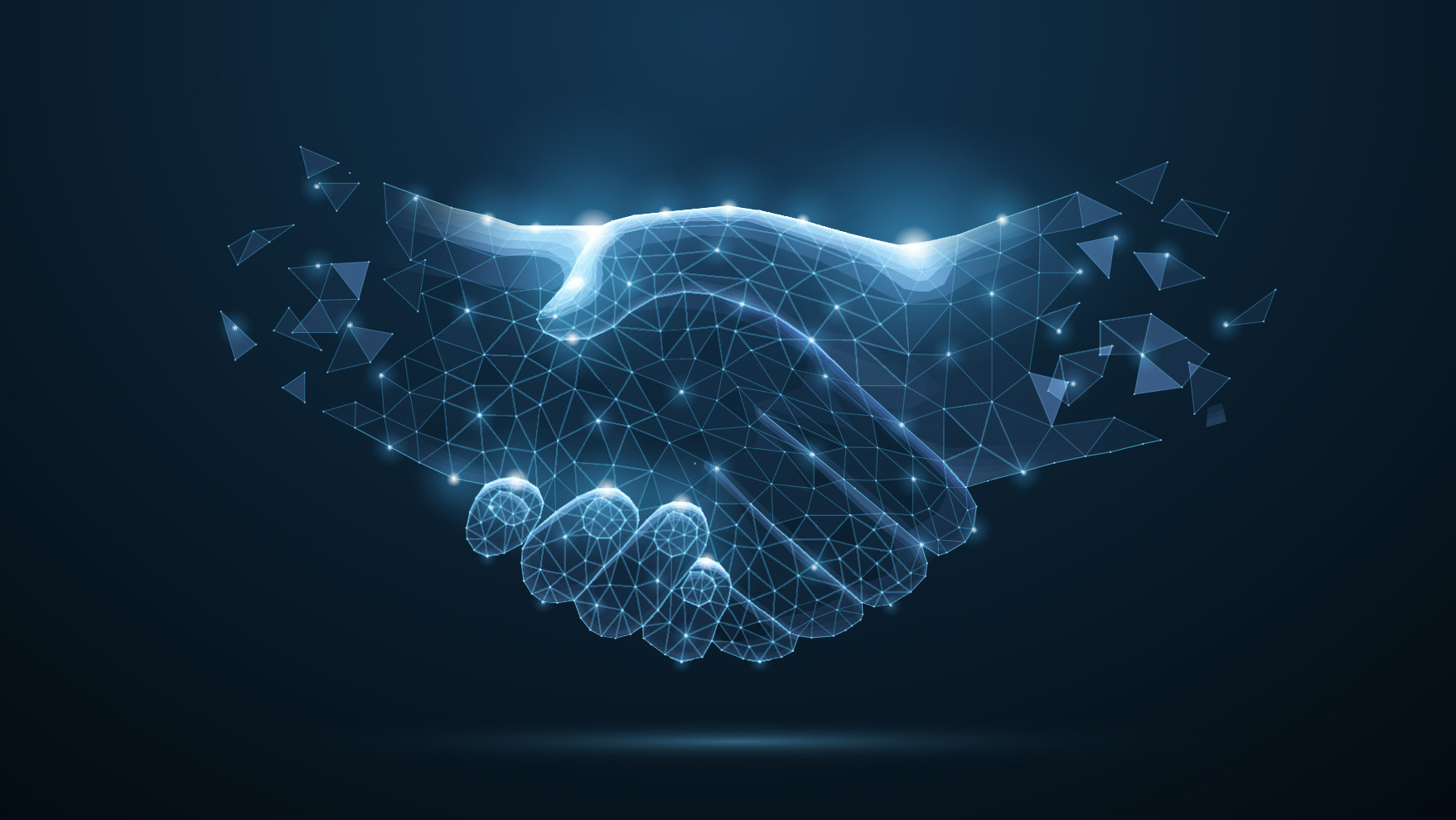Flexible Classroom Design
Flexible classroom design is certainly not a new concept. The benefits of providing flexible spaces within learning environments have been studied for years and the supportive research remains strong. The phrase “flexible classrooms” often refers to movable furniture like desks, chairs, computer hardware, SmartBoards® and flexible whiteboards. But we at Kwik-Wall Company believe that a true “flexible classroom” must provide additional room reconfigurations and the ancillary benefits they provide to engage students and empower teachers to create learning environments that improve outcomes.
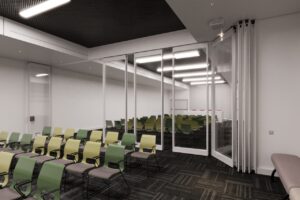 Overall, research suggests that flexible classroom design can have a significant and positive impact on both students and teachers. Numerous studies have been conducted on the benefits of flexible classroom design. One study published in the Journal of Educational Psychology found that flexible seating options, such as beanbag chairs and standing desks, improved students’ academic performance and helped them stay more engaged during class. The study also found that students who had more control over their learning environment felt more motivated and invested in their education. Another study published in the Journal of Learning Spaces found that flexible classroom design can promote collaboration and communication among students. The study noted that when students can easily move around and work together in groups, they are more likely to develop stronger social skills and feel a sense of community in the classroom.
Overall, research suggests that flexible classroom design can have a significant and positive impact on both students and teachers. Numerous studies have been conducted on the benefits of flexible classroom design. One study published in the Journal of Educational Psychology found that flexible seating options, such as beanbag chairs and standing desks, improved students’ academic performance and helped them stay more engaged during class. The study also found that students who had more control over their learning environment felt more motivated and invested in their education. Another study published in the Journal of Learning Spaces found that flexible classroom design can promote collaboration and communication among students. The study noted that when students can easily move around and work together in groups, they are more likely to develop stronger social skills and feel a sense of community in the classroom.
In addition to benefiting students, flexible classroom design can also have a positive impact on teachers. A study published in the Journal of Environmental Psychology also found that teachers who had more control over their classroom layout felt more satisfied with their job and had a greater sense of autonomy. This can lead to higher teacher retention and improved job performance. From experience, initial pedagogy may have to be adjusted, but once embraced, teachers’ one-on-one impact with students can be accelerated within the flexible classroom.
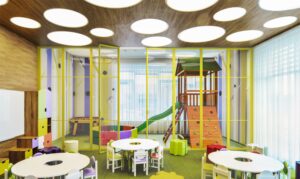 Since 1961, Kwik-Wall has served schools with movable walls to divide classrooms, gymnasiums, stages and collaborative learning environments. We offer a full range of movable wall systems that can add more to a flexible room than just rearranging furniture. The actual room can be reconfigured with movable walls that can easily be operated by students and teachers alike to create environments that promote better learning. Traditional solid movable walls have been used for decades to divide classrooms to allow one space to open up into two environments. But recent modern flexible spaces incorporate a combination of both solid panels and side sacking and sliding moveable glass wall partitions that can supercharge the benefits for students and teachers.
Since 1961, Kwik-Wall has served schools with movable walls to divide classrooms, gymnasiums, stages and collaborative learning environments. We offer a full range of movable wall systems that can add more to a flexible room than just rearranging furniture. The actual room can be reconfigured with movable walls that can easily be operated by students and teachers alike to create environments that promote better learning. Traditional solid movable walls have been used for decades to divide classrooms to allow one space to open up into two environments. But recent modern flexible spaces incorporate a combination of both solid panels and side sacking and sliding moveable glass wall partitions that can supercharge the benefits for students and teachers.
Glass movable wall systems provide a litany of specific benefits, including providing both more daylight to reach within a classroom and providing an acoustic separation that meets ANSI S12.60-2010 requirements for wall systems requiring a minimum 45 STC between corridor and classroom spaces. Kwik-Wall’s new Luminous STELLA™ movable glass wall systems achieve up to 50 STC, meeting even the highest levels of sound isolation. Not just having windows and solid walls within a classroom, a movable glass wall provides an added benefit for reconfiguration to develop separate learning spaces where students can collaborate. And since these systems have semi-automatic electric seal operation, students can operate the systems without any need for removable tools, providing more engagement and “ownership” of the room configurations.
Glass walls in school classrooms have many benefits. First, they allow natural light to enter the classroom, which can create more welcoming and positive learning environments. Natural light has also been shown to improve cognitive function, mood, and overall health, which can lead to better academic performance. Studies have shown that students in daylit classrooms perform better in both reading and math tests than those in classrooms without natural light. Additionally, research also found that natural light positively contributes to higher academic performance in reading and science, as well as supporting attention, stability of the circadian cycle, overall health, mental health, and comfort, all of which lead to better academic performance.
Second, glass walls can promote transparency and accountability in the classroom. With movable glass walls, teachers and students can easily see into other classrooms and common areas which discourage inappropriate behavior and promote a sense of community. By providing translucent glass films or back-painted glass, designers can also provide students with a level of privacy at the same time allowing natural light to enter deep into spaces.
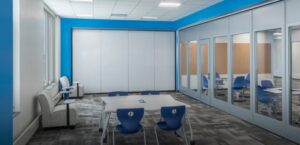 Third, glass walls can promote collaboration and communication among students and teachers. With the ability to see and hear what is happening in other areas of the school, students and teachers can easily coordinate and work together on projects and activities. Movable glass walls allow students to truly interact with the spaces themselves, building on the benefits provided with traditional flexible furniture. One facility that demonstrates how students interact with their movable classroom walls to create different learning spaces is at Dickenson Middle School in Dickenson, North Dakota. DLR Architects designed, and Mortenson Construction built this school to be highly flexible using both traditional operable partitions with full-height writing surfaces and movable glass walls that could create different workspaces on two sides of the classroom. To see how this works, link here to DLR’s project profile. https://www.dlrgroup.com/work/dickinson-middle-school/
Third, glass walls can promote collaboration and communication among students and teachers. With the ability to see and hear what is happening in other areas of the school, students and teachers can easily coordinate and work together on projects and activities. Movable glass walls allow students to truly interact with the spaces themselves, building on the benefits provided with traditional flexible furniture. One facility that demonstrates how students interact with their movable classroom walls to create different learning spaces is at Dickenson Middle School in Dickenson, North Dakota. DLR Architects designed, and Mortenson Construction built this school to be highly flexible using both traditional operable partitions with full-height writing surfaces and movable glass walls that could create different workspaces on two sides of the classroom. To see how this works, link here to DLR’s project profile. https://www.dlrgroup.com/work/dickinson-middle-school/
The sliding operable partitions have magnetic dry-erase boards that Kwik-Wall can provide with either Liquid Crystal style painted surfaces or using porcelain enamel steel white boards. Dickenson Middle School can push these movable walls from one side of the overall room to the other to create “teaching zones” where students can write collaborate and problem-solve on their own whiteboards.
Dickenson Middle School principal, Casaundra Francis lauds the school’s design, “As our teachers developed curriculum to match the flexible classrooms, the students have really started to interact with and collaborate with all of the moving parts.” At the A4LE Midwest Region Conference in 2019, the current Dickenson School District superintendent, Dr. Martin Lewton, spoke about how the school had already seen improvement within the middle school student engagement statistics. Principal Francis continues, “When the school first opened in 2018, pre-COVID, a district research study showed positive student engagement among middle schoolers over a previous survey. Now back post-pandemic, we are now again starting to see the facility rise to the benefits of the design as intended. Creating personal learning spaces and experiences can help students stay engaged and motivated.”
When designing flexible classrooms with glass movable partitions, designers should strongly consider the learning environment’s overall acoustics. Classrooms with sound reflective, hard surface glass can pose speech intelligibility issues with students and teachers, especially in rooms that have four sided hard surfaces. Flutter echo and background noise from HVAC and other sources can become an issue with glass and rooms with writing surfaces impairing optimal learning. Some studies indicate that students may not hear as much as 25% of spoken words in some learning environments. To counter this, rooms with glass operable glass partitions should consider installing highly absorptive ceilings tiles, diffusers and carpet flooring that provide a high level of Noise Reduction Coefficient (NRC) to reduce the flutter echoes within the rooms and improve intelligibility. To learn more, Gary Madaras, PhD from Rockfon authored a very concise illustrative report about interior space acoustics. Learn more at Acoustic Absorption | Rockfon.
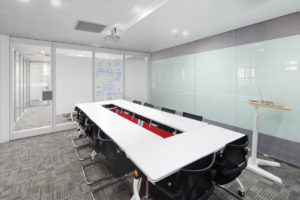 Engaged and motivated are true achievements for middle schoolers. Kwik-Wall offers a new product line that can help achieve the same type of engagement seen by Dickenson Middle School. Kwik-Wall’s new LUMINOUS™ movable glass wall lines provide three different styles of movable glass walls with acoustical values between 35 STC to 50 STC. A major benefit of the LUMINOUS line is the ability to integrate back-painted glass writing surfaces that are built into the STELLA™ and LUNA™ systems. The manufacturing process of these glass walls provides writing surfaces at very little upcharge to the overall price of the standard clear systems. And, since sealed within the inside surface of the glass, the painted whiteboards are completely protected and will never fade or shadow. Students can use traditional dry-erase markers onto the clear side of the glass surface and simply wipe clean when done. LUMINOUS™ movable glass walls by Kwik-Wall still provide all of the benefits of acoustical separation, reconfigurability, and daylighting, and affords even more whiteboard surfaces for interactive collaborative learning.
Engaged and motivated are true achievements for middle schoolers. Kwik-Wall offers a new product line that can help achieve the same type of engagement seen by Dickenson Middle School. Kwik-Wall’s new LUMINOUS™ movable glass wall lines provide three different styles of movable glass walls with acoustical values between 35 STC to 50 STC. A major benefit of the LUMINOUS line is the ability to integrate back-painted glass writing surfaces that are built into the STELLA™ and LUNA™ systems. The manufacturing process of these glass walls provides writing surfaces at very little upcharge to the overall price of the standard clear systems. And, since sealed within the inside surface of the glass, the painted whiteboards are completely protected and will never fade or shadow. Students can use traditional dry-erase markers onto the clear side of the glass surface and simply wipe clean when done. LUMINOUS™ movable glass walls by Kwik-Wall still provide all of the benefits of acoustical separation, reconfigurability, and daylighting, and affords even more whiteboard surfaces for interactive collaborative learning.
Overall, movable glass walls in school classrooms can create a more positive, collaborative, and safe learning environment while also promoting transparency and accountability. Engage Kwik-Wall or one of our local distributors, to help you design more flexibility into your learning environments.
Visit www.Kwik-Wall.com for more detailed product information.
Blog Author:
Scott Staedter is an expert in the movable wall industry with more than 30 years of experience. Mr. Staedter has collaborated or overseen operable partitions designs for dozens of projects designed along with many top educational architectural firms including Huckabee, Fanning & Howie, DLR, PBK, Jacobs, ATS&R, Cuningham, EUA and many more. Mr. Staedter has been a member of the Association for Learning Environments since 2010 and has frequented both regional and national A4LE conferences. Back in 2011, Mr. Staedter collaborated with the team at ATS&R on the “School of the Future – 2021” project called the ZON. Now already twelve years later, these “future conceptual designs” are in full implementation within schools throughout North America with the incorporation of movable glass walls, traditional operable partitions, rotating walls to share mounted interactive smart technology between classrooms, sliding folding exterior glass walls (to allow increase ventilation and airflow), vertical lift partitions, the use of flexible furniture, and increased technology focused on collaborative teaching pedagogy. To contact Scott email his consultancy at scott@staedter21consulting.com or through Kwik-Wall Company where he is VP-Strategy at staedters@kwik-wall.com.
Subscribe to our newsletter – Kwik-TAKESTM– a quarterly quick read of helpful operable wall specifications and design tips.


